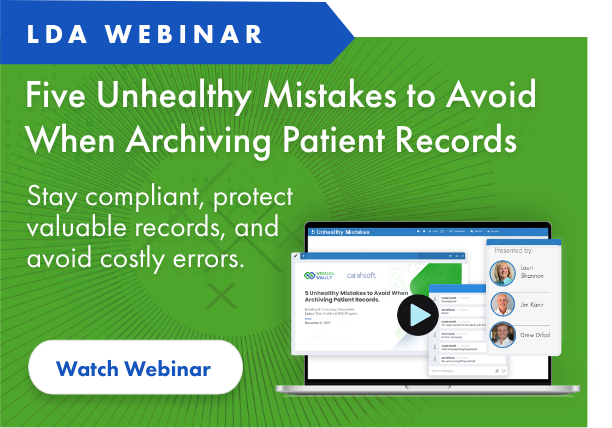Five Unhealthy Mistakes to Avoid When Archiving Patient Records
Initiating & Executing a Successful Legacy Data Archive (LDA) Program.

Many organizations either don’t appreciate the necessity of actively managing legacy patient records or turn a blind eye to it. The list of priorities is long, and legacy data archiving (LDA) often just doesn’t make it to the top of the list. This is particularly true on the heels of an acquisition, when that to-do list becomes significantly longer – having acquired new people, new processes and new technology. And very importantly, you’ve likely acquired new EHR(s), and the complexities that go along with it.
Every additional year those legacy EHR systems remain online, the risk associated with them compounds. Old servers and software aren’t just inefficient; they’re unstable, unpatched, and prime targets for hackers. System crashes, data corruption, ransomware, or a breach of protected health information (PHI) can spiral into sub-par patient care, reputational damage, regulatory penalties, and multimillion-dollar fines.
Yet, with integration work consuming bandwidth, many teams keep legacy platforms running for compliance purposes and access to old records. In doing so, they expose themselves to the failures IT leaders fear most. The secondary headaches like extra logins, clunky interfaces, escalating licensing fees, only add weight to the real problem: fragile systems creating unnecessary and unacceptable risk.
Once you’ve chosen to proactively manage your legacy patient records, there are critical considerations before you get started. These considerations can help you avoid the costly mistakes that turn legacy patient records into operational quicksand.
In this paper, we’ll explore the five most consequential mistakes healthcare organizations make when archiving legacy data. You’ll find out how to turn your approach from a high-risk, reactive cost center to a strategic advantage; one that reduces expenses and operational complexity.
Let’s start with the most costly trap – one that you might not have expected.
Table of Contents
- Mistake 1 - Doing Nothing: The Hidden Cost of Inaction
- Mistake 2 - Merging Patient Data: Compromising Integrity and Compliance
- Mistake 3 - Overlooking Compliance and Retention Complexities
- Mistake 4 - Undervaluing Historical Data
- Mistake 5 - Choosing a Vendor Not Well-Positioned for the Future
- From Legacy Burden to Strategic Asset
- About VisualVault
- Sources
Mistake 1 - Doing Nothing: The Hidden Cost of Inaction
We’ve seen from first-hand experience that archiving has become an afterthought for most organizations. A reactive necessity rather than a strategic priority. Enterprises continue running legacy platforms “because that’s how it’s always been done.”
The consequences compound quickly. Every additional year these systems remain online, the risks grow: unpatched servers become prime targets for hackers, fragile software succumbs to crashes, and PHI exposure turns into regulatory fire drills. These are the nightmare scenarios that keep IT leaders up at night. [1]
On top of these risks, clinicians and HIM staff are stuck juggling multiple logins and outdated interfaces, slowing them down at the very point where accuracy and speed matter most. Time lost to system-hopping and password friction directly competes with patient care and adds frustration to already overburdened teams.
And while the risk profile grows, the cost burden doesn’t shrink. Maintaining an active legacy EHR requires thousands of dollars per physician each year in licensing fees, vendor support, and IT overhead – even if the system is only kept online for historical access. [2]
Licensing, hardware, and staffing consume resources that could otherwise be invested in secure, modern infrastructure. Yet 73% of healthcare organizations still rely on legacy operating systems despite the inefficiencies.[3]
The longer these platforms stay online, the greater the fragility: unexpected crashes, sluggish performance, and corrupted files that interrupt patient care when speed matters most. And because many are unpatched, each year they stay active increases the likelihood of a breach.
Finally, ad hoc approaches to archiving often lead to over-retention. It complicates audits and increases compliance exposure. [4] Regulators treat uncontrolled retention as negligence, with HIPAA civil penalties reaching $50,000 [5] per violation and annual caps exceeding $1.5M. [6]
The smarter approach is to put a formal archiving strategy in place. Proactive archiving lets organizations systematically decommission fragile systems, reduce the total cost of ownership, and secure frictionless, compliant access to historical records. Most importantly, it removes the single biggest risk: exposure from outdated, failure-prone platforms.
Avoiding inaction is just the first step. The next mistake to avoid is another pit that many organizations fall into — attempting to merge disparate legacy records directly into your primary EHR.
“The consequences compound quickly. Every additional year these systems remain online, the risks grow: unpatched servers become prime targets for hackers, fragile software succumbs to crashes, and PHI exposure turns into regulatory fire drills.”
Mistake 2 - Merging Patient Data: Compromising Integrity and Compliance
In the rush to simplify operations after a merger or acquisition, healthcare organizations are dealing with immense pressure to consolidate patient records. After all, “just merging the data” seems like a fast track to efficiency, so why not go down that road? It actually introduces all sorts of issues like compliance risks, data integrity problems, and long-term technical debt that outweigh any short-term benefit.
The core challenge is that patient records from different EHRs rarely align. Formats, identifiers, and structures vary, meaning, among other things, the same patient can appear under multiple record numbers. For instance, one patient might have different medical record numbers across systems. It’s a messy process full of complexities like data duplication and inaccuracies.
In one survey, 33% of denied claims were tied to patient matching / duplicate record issues. [7] Duplicate patient records rates exceed 20% in some hospitals, costing nearly $1.7 billion per year [8] in malpractice exposure.
Beyond duplication and inaccuracies, not all data transfers successfully during a migration. Issues like failed imports, broken links, or corrupted files come up frequently. These lead to permanent gaps in patient histories.
It strains the performance of the active EHR, slowing response times and frustrating clinicians. It comes as no surprise that 83% [9] of data migration projects either fail or exceed their budgets or timelines. For this reason, major EHR vendors typically refuse to support full record merges, since the liability of corrupted or incomplete data falls back on them.
While data is being transitioned or archived, legacy systems must stay online, forcing staff to juggle multiple platforms for historical records. This increases the risk of delays, errors, and workflow disruptions.
Merging records also introduces compliance risks. When records are restructured to fit a new EHR schema, audit trails can be disrupted. Timestamps and access logs (critical for HIPAA compliance) might be altered or lost in the process, creating gaps regulators view as red flags.
The financial consequences are devastating. In one case, a major healthcare system in the southeastern U.S. faced a $2.5 million HIPAA fine after failing to monitor access to its legacy systems. Over five years, unauthorized employees were able to view 24,000 patient records, showing how weak audit controls and fragmented data environments quickly turn into high-stakes compliance failures.
Trying to replicate EHR functionality with “mini-EHRs” only compounds complexity, cost, and compliance risk. A smarter path you should consider is using a true archive: one that centralizes records, maintains audit trails, and removes the need to prop up fragile legacy systems.
Even with the right separation strategy, compliance can still falter if you underestimate how complex retention and regulatory management really are.
“The core challenge is that patient records from different EHRs rarely align. Formats, identifiers, and structures vary, meaning, among other things, the same patient can appear under multiple record numbers.”
Mistake 3 - Overlooking Compliance and Retention Complexities
Perhaps one of the most overlooked challenges in legacy data archiving is compliance and retention. Too often, organizations assume that as long as the data is “kept somewhere,” they’re safe. In reality, keeping records in outdated systems with inconsistent retention practices creates compliance blind spots. Without clear rules on what to keep and what to dispose of, organizations risk over-retention that drives costs up or under-retention that leaves them exposed during audits.
Retention rules are anything but simple. Regulations vary by state, record type, and patient age. They often require adult records to be stored for 7-10 [10] years, and pediatric or obstetric records for much longer. Without a clear and standardized means of managing records retention, organizations swing between two extremes: over-retention, which drives up storage costs and exposes PHI to unnecessary risk, or under-retention, which leaves them vulnerable during audits.
Relying on legacy EHRs to “store everything” only makes retention even harder to manage. Each system applies different data structures, identifiers, and audit protocols. In one multi-hospital system, HIM staff had to manage a dozen different retention schedules – a near impossible task. When retention is inconsistent across systems, organizations risk holding on to data far longer than required. Or worse, being unable to prove compliance during an audit.
Then there’s the issue of auditability. Left running for years, legacy systems degrade: logs go missing, access records become inconsistent, and organizations lose the ability to verify long-term accountability to regulators.
These gaps don’t just create compliance risk – they also drive cost. Gartner [11] estimates that 30% of enterprise storage is “dark data” – kept but never used. Every extra record also widens the surface for breaches, with the average cost of a healthcare data breach reaching $11 million in 2023. [12]
It’s advisable to decommission legacy systems and centralize records into an environment that:
- Preserves original data in its native format (no restructuring that alters context),
- Applies automated retention rules mapped to state and federal regulations, and
- Maintains clear, immutable audit trails for regulators.
As you evaluate your archiving strategy, ask yourself this: is my current vendor simplifying retention and compliance? Or, are they making things more complicated by keeping me tethered to old, failure-prone systems?
Maintaining compliance and retention is certainly important, but it’s only part of the picture. The other mistake many enterprises make is overlooking the strategic value of the very data they’re working so hard to store. Don’t look at historical clinical and financial data as a liability – see it as an asset that directly improves patient care and reporting.
“In reality, keeping records in outdated systems with inconsistent retention practices creates compliance blind spots.”
“All these problems have one root cause: failing to recognize that legacy data must be managed as a living, regulated asset rather than a static archive.”
Mistake 4 - Undervaluing Historical Data
Too many enterprises treat historical patient and financial records exclusively as a compliance requirement. But these archives directly support value-based care, quality reporting, and organizational growth. Underestimating their value is an expensive mistake.
Legacy data is vital for care quality in clinics. Access to long-term patient histories improves clinical decision-making, population health analytics, and value-based care programs such as HEDIS reporting. Without this data, clinicians operate with missing information that drives misdiagnoses, redundant testing, and gaps in chronic disease management.
For instance, hospitals implementing better clinical data sharing and predictive modelling under VBC have seen hospital readmissions drop by around 10% [13], highlighting how well-maintained historical data contributes to tangible improvements in patient outcomes.
Financially, archived data powers revenue cycle management, payer audits, and M&A activity. Inaccurate or inaccessible historical billing records can slow collections and trigger payer disputes.
Conversely, demonstrating clean, accessible archives can make a health system more attractive to investors or acquirers. That’s the story we see in investment patterns. Private capital allocated to VBC-aligned assets surged from about 7% to nearly 30% [14] of hospital investment between 2019 and 2021.
Time and time again, we’ve seen what happens when enterprises underestimate the value of historical data. They end up replicating the very inefficiencies they sought to eliminate. Not only that, but HIM teams wrestle with repeated audits and finance staff chase incomplete records.
Speaking of finance, incomplete or inaccessible billing archives derail payer audits, turning lost data into lost revenue. Retention gaps or over-retention can trigger costly penalties. All these problems have one root cause: failing to recognize that legacy data must be managed as a living, regulated asset rather than a static archive.
By contrast, a modern solution can consolidate clinical and financial histories into a single, searchable environment. With automated retention schedules, role-based access controls, and unified authentication, you can unlock the real value of your enterprise’s historical data. It turns what was once a liability into a driver of care quality, financial performance, and strategic growth.
This type of solution unlocks the true value of historical data – improving care quality, compliance readiness, and financial performance. That’s why even the best strategy depends on one final decision: choosing the right vendor for the future.
Mistake 5 - Choosing a Vendor Not Well-Positioned for the Future
Healthcare organizations often choose archiving vendors based on immediate cost savings or familiarity with incumbent systems. They feel it’s the safe and economical choice. But without a long-term strategy, today’s vendor decision can lock you into tomorrow’s problems: limited scalability, mounting compliance risk, and technology that can’t keep pace with clinical and regulatory change.
Modern healthcare environments aren’t static as they once used to be. Regulatory frameworks evolve, security threats are more complicated than ever, and patient populations expect real-time, digital-first access to their health information. Vendors tied to rigid, pre-cloud architectures limit future scalability, leaving organizations unable to adapt as care models, security standards, and regulations continue to change.
Legacy vendors often require custom schemas for each EHR, while modern solutions can ingest data as-is. Cloud-based architectures also allow seamless expansion to support new facilities, new care models, and rapidly changing regulatory requirements – without lengthening implementation timelines.
Surveys [15] show that ~70% of health IT professionals have already migrated key systems to the cloud, and another ~20% plan to do so in the next two years. Platforms unable to support cloud deployment aren’t just outdated – they’re falling further behind every year.
Outdated stacks don’t just create IT headaches. They drastically affect operations and even market value. When it takes months of custom development to meet new retention rules or interoperability standards, organizations lose agility.
At the same time, vendors that can’t deliver secure access to historical records weaken confidence with regulators, investors, and potential M&A partners. On the other hand, hospitals that consolidated vendors onto integrated, cloud-enabled platforms reported operational cost savings of up to 14% [16] within just a few years.
The right choice is to evaluate vendors not only on immediate delivery, but on whether they are positioned to support you for the next decade.
Look for solutions that are:
- Cloud-native for scalability, compliance, and security
- Schema-agnostic to ingest data without costly transformations
- Regulatory-ready with automated retention and audit reporting
- Future-focused with active development and support for interoperability standards
“But without a long-term strategy, today’s vendor decision can lock you into tomorrow’s problems: limited scalability, mounting compliance risk, and technology that can’t keep pace with clinical and regulatory change.”
From Legacy Burden to Strategic Asset
About VisualVault
VisualVault is the trusted partner for healthcare organizations looking to simplify the legacy data archiving process and turn it into a strategic advantage. With decades of expertise in enterprise content management, we specialize in archiving clinical and operational records across diverse platforms while ensuring accessibility and cost efficiency.
- Industry Leadership: The largest healthcare provider in the U.S. has relied on VisualVault’s LDA solution for over a decade.
- Scale: Over 1.1 billion patient records under management, archived from 50+ EHR systems.
- Client Trust: Serving 300+ LDA clients nationwide, from large hospital systems to specialty practices.
Our approach is designed to drastically simplify operational complexities and reduce costs. While other solutions tend to have an implementation timeline of 4-11 months, VisualVault can complete a full archive within 4-6 weeks. Every month spent maintaining legacy systems costs your organization $40,000–$100,000 in unnecessary expenses, such as maintenance and licensing costs.
Contact our experts today to find more about how our simplified archiving strategy can reduce costs, ensure compliance, and simplify operations.
About the Author

Jim Leondard
A lifelong healthcare professional, having served as CIO of several major healthcare systems. Presently, Jim serves as an expert healthcare practice lead for VisualVault.
Sources
- https://www.sciencedirect.com/science/article/pii/S1386505617300394
- https://www.commonwealthfund.org/publications/newsletter-article/cost-biggest-barrier-electronic-medical-records-implementation
- https://www.himss.org/sites/hde/files/media/file/2022/01/28/2021_himss_cybersecurity_survey.pdf
- https://www.medpro.com/documents/10502/2837997/Guideline_Record%2BRetention.pdf
- https://www.ama-assn.org/practice-management/hipaa/hipaa-violations-enforcement
- https://www.hipaajournal.com/what-are-the-penalties-for-hipaa-violations-7096/
- https://gkc.himss.org/resources/patient-matching-and-impact-immunization-community
- https://www.chiefhealthcareexecutive.com/view/the-deadly-cost-of-duplicate-patient-records-viewpoint
- https://www.gartner.com/en/documents/897512
- https://www.healthit.gov/sites/default/files/appa7-1.pdf
- https://www.gartner.com/en/documents/3883565
- https://www.gartner.com/en/documents/3883565
- https://www.ama-assn.org/practice-management/payment-delivery-models/outcomes-over-volume-how-prevention-powers-value-based
- https://www.mckinsey.com/industries/healthcare/our-insights/investing-in-the-new-era-of-value-based-care
- https://medcitynews.com/2024/01/securing-the-healthcare-cloud-in-2024-with-cloud-managed-services/
- https://www.scholars.northwestern.edu/en/publications/hospital-consolidation-and-costs-another-look-at-the-evidence



